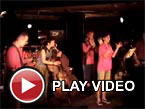Graveyards, "Psalm Alarm"
Tracking down Graveyards releases is like taking on a part time job. Scattering their music across miniscule private press labels blink-and-miss-it editions, the current threat level of incoming albums is always elevated. Being a trio with a sax player, they’re often tagged as jazz or scumjazz, but their reach goes much further that the remit of those genres.
As a unit John Olson (Wolf Eyes), Hans Buetow and Ben Hall (both members of Mêlèe and Death Knell) easily transcend the limitations of tags. Their albums don’t appear to be compiled or released in any sort of chronological order, their evolution scattered randomly across CD-Rs, cassettes and vinyl. The frequency of their musical discharges may make it look like these things are just being shat out, but the quality shows that this is light years from the truth.
This particular cassette release is a typically good looking package for the band, a Princely purple wraparound card sleeve and a pile of hand drawn skulls, the handmade aesthetic matching their idiosyncratic path. Through their hours of jams (and being members of numerous different projects), Graveyards have mastered the ability to have numerous distinctive sounds they can cross pollinate. Like some swelling and engorging mass, they sound distinctly like themselves, but utterly different from their other releases at the same time. Head and shoulders above the innumerable ancillary and pristine studio units of the improvising trio world, the fidelity here is just above the usual American Tapes murk levels.
This is a generally more structured release, with Ben Hall leading the way with simple percussion patterns that move between brutal loops and the threateningly restrained tethering of tempos. Tapped out cymbal knocks create stiletto patterns over a deep bass note drone, leaving Olson warming the air in-between. The Graveyards music here bristles with safety pinned energy, carried by a wind from a deep, dirty pit. A battered bell and metal percussion led piece, “Three” has Olson and Buetow invoking ghosts, replying and entwining with Hall’s brutality. Each player seems to know exactly when to keep it in or drag it out. The other untitled highlight, “Two”, haemorrhages an unspoiled regurgitation of sawn cymbal sound with a Staccato cello taking the strain. The horn moving from braying howl to mournful passage on this cut perfectly sums up the trio’s refusal to sit comfortably.



